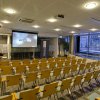Danske Bank’s reception: Estonian Entrepreneurship Environment Today and Tomorrow – Feb 3, 2015
Danske Bank’s history dates back to mid-19th century, and is today Danish biggest financial concern. Being also one of the biggest Nordic banks the group enlarged to Finland and the Baltics in 2006. Back in spring 2008 the Danske Bank A/S Eesti filial was registered, though the bank operated under the Sampo Pank trademark till autumn 2012. Danske Bank Group is active in 15 countries with over 20.500 employees (inc approx. 500 people in Estonia). The bank serves over 5 million customers. Danske Bank has been member of the Danish-Estonian Chamber of Commerce since its establishment in 2007 and have traditionally tight ties ever since.
This time we were invited to Danske Bank along with the other Nordic and American chambers of commerce in Estonia to hear about the perspectives from both the bank’s side as well as by the Estonian Minister of Finance, Mrs Maris Lauri.
Ivar Pae reminded that Danske Bank believes that businesses foster from exchanging ideas and learning from others. Therefore the bank is pleased to organise events where businesses from both international and Estonian community can interact and share their experiences. In addition to the statistics and influence of Russia, Mr Pae also talked about the new financial services providers. “In the future banks create value to their customers by relevance and predictability. To do so they really need to understand customers' business and combine simple but relevant advisory with the technology. Also we will see newcomers to the sector empowered by new technology and further changes how customers interact with the bank,” Ivar Pae. (Ivar Pae's presentation material is downloadable here).
Mrs Lauri was stating that the economic environment is unstable with several different variables that each have a sufficient stake of the overall pie of economic perspectives. Therefore making any kind of prognosis or forecast is especially ungrateful task. If in the past the future scenarios included the most likable, highly likable, possibly likable and the unlikely outcome, then nowadays all scenarios that the economists tend to put together are likable. The probability scenario is built-in and depends on factors the states can no longer influence in many cases. There’s all reason to be rather pessimistic about the outlook on economic environment, though being pessimistic is not a sustainable choice and can definitely not be an alternative for business people. Therefore the optimal outcome depends on us being optimistic towards the future.
The program of the event included networking and speeches from Ivar Pae, Head of Baltic Banking at Danske Bank and Mrs Maris Lauri, Minister of Finance. The event was free of charge for chambers members and was fully “sold out” within two days after announcing. The accommodates 60 people at the event and thank each and everyone who arrived in time and enjoyed the reception.
Sincerely
Merli Lindberg
Danish-Estonian Chamber of Commerce
Photos by Ardo Holts.





















